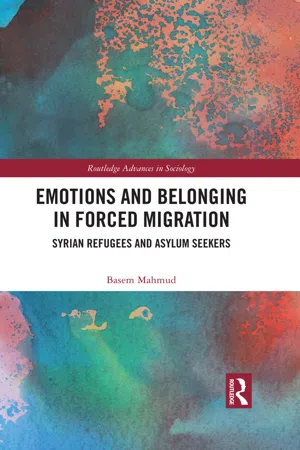
Emotions and Belonging in Forced Migration
Syrian Refugees and Asylum Seekers
- 240 pages
- English
- ePUB (mobile friendly)
- Available on iOS & Android
About This Book
Emotions and Belonging in Forced Migration takes a sociology of emotions approach to gain a better understanding of the present situation of forced migration.
Furthermore, it helps to bring the voices and views of forced migrants to academic and public debates in Western society, where they have been generally absent and often investigated with predefined concepts and categories based on theories having little relevance to their cultural and social experiences. This work, however, is based on an inductive methodology that carefully carries the voices of forced migrants throughout the research. Therefore, it will be of interest for various audiences from different disciplines in social sciences, as for any readers seeking to learn more about the refugees in his building, neighbourhood, city, or country.
Finally, it provides an insightful lens for those who wants to know more about Syria and the Arab uprisings after 2010: It is the first study of what Syrians feel during the entirety of their difficult ordeal fleeing Syria, traversing different countries in the global South, and landing in Western ones. No other book treats this thematic focus with the same geographic and temporal breadth.
Frequently asked questions
Information
Chapter 1
The study of forced migrants’ emotions and belonging*
What approaches exist to investigate forced migrants’ emotions?
aiming for the study in the field of a sociology of emotions that focuses on the general functions of emotions in interactions during the process of migration, none of the research done so far on this subject goes far enough. The potential of an accordant perspective has not been fully tapped yet.
Belonging: which definition?
- Belonging as ‘fitting in’ and being accepted. After reviewing more than 21 articles that explicitly defined belonging, researchers arrived at the following conclusion: “Sense of belonging was often referred to as a personal feeling or perception of an individual as they related to or interacted with others, a group, or a system that was separate from an individual’s actions, behavior or social participation. Feeling needed, important, integral, valued, respected or feeling in harmony with the group or system, characterized most definitions of belonging” (Mahar et al., 2013). However, we might ask, does ‘fitting in’ and being important or accepted in the group suffice to belong? Mahar et al. (2013) present five necessary elements for understanding the sense of belonging. These are: subjectivity (about being accepted and fitting in), groundedness (referent group that serves to ground individuals’ subjectivity), reciprocity (sense of connectedness between the individual and the referent group), dynamism (refers to the physical and social environments), and self-determination (the right of the individual to choose to interact with referents). May (2011) also remarks on this issue. For her, belonging is an “intersubjective experience that necessarily involves other people. We make claims for belonging which others either reject or accept and therefore, mere familiarity with a place, a group of people or a culture is not enough for us to gain a sense of belonging” (2011, p. 370). This means that belonging is not just about being part of a social fabric, but also about “the ways in which social bonds and ties are manifested in practices, experiences and emotions of inclusion” (Anthias, 2008, p. 8).
- Belonging as an ontological state. Here, belonging is more than fitting in or being accepted; it is something more ontological, “more fundamental to who and what we are” (Miller, 2003, p. 217), which means it constitutes our identity whether we have this feeling or not (Miller, 20...
Table of contents
- Cover
- Half Title
- Series Information
- Title Page
- Copyright Page
- Dedication
- Table of Contents
- List of Figures
- List of Tables
- Acknowledgements
- Introduction
- Chapter 1 The study of forced migrants’ emotions and belonging
- Chapter 2 Disturbed hope
- Chapter 3 Frustration and the birth of a ‘definitive’ migration plan
- Chapter 4 Emotions and self-presentation during the journey
- Chapter 5 The path to belonging: “I hope that I can start a new life ‘here’”
- Final discussion
- Index